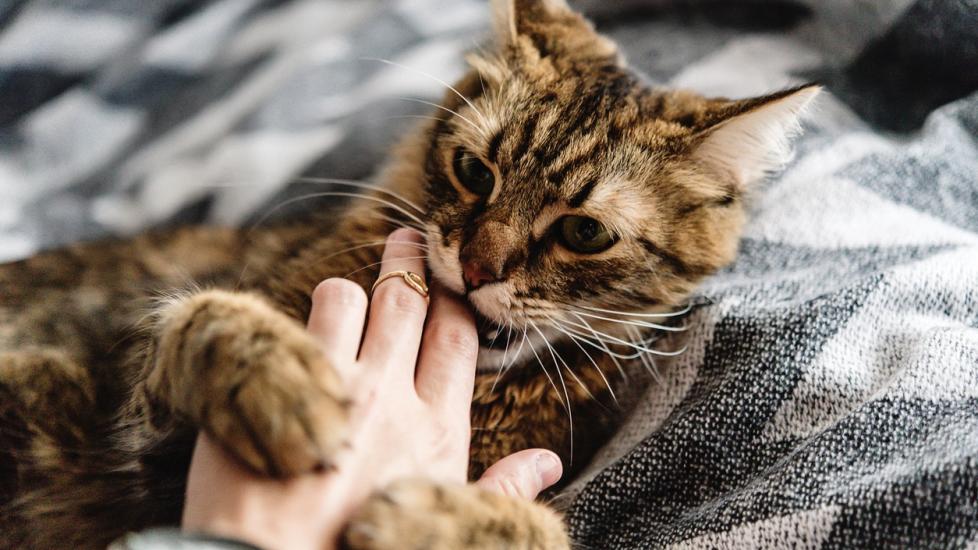Why Does My Cat Attack Me Unprovoked?
Have you ever been peacefully petting your cat, and they suddenly attack you? Or maybe you were just sitting near them and they decided to bite and swat at you. Why do cats do this? What causes a cat to attack you when unprovoked?
If this is a sudden change in behavior, have your cat checked out to rule out pain-induced aggression caused by an underlying health issue. Otherwise, take a look at these most common reasons for a cat being aggressive toward a person.
Play Aggression
While play aggression can be an issue between feline playmates, it can also happen when a cat is playing with you or someone else in the family. If a person’s hands and arms are too close to the cat during play, the cat may bite, scratch, and pounce on the person, leading to injuries. Cats may also lunge from under beds during play aggression episodes.
Play aggression can be managed by ignoring your cat and leaving the room during the play session if it becomes too intense. Preventing cats from hiding under beds if they are prone to pouncing when playing is also helpful. Try praising and rewarding appropriate play behaviors with treats.
Petting-Induced Aggression
Petting-induced aggression is when a cat either becomes overexcited from a petting session or reacts negatively to unwanted petting. They may even like the petting at first, but then want you to stop.
Petting aggression can also occur when picking up your cat or performing hygiene tasks such as brushing, bathing, and nail trims. It can happen both with strangers and people the cat is familiar with.
A cat should be left alone during petting-induced aggression episodes, particularly if they are eating. If you want to train against petting-induced aggression, reward your cat for staying calm during short petting sessions and then extend them as long as your cat remains calm. However, never force petting on your cat.
Children should be supervised closely until they can pet a cat gently and are able to learn the visual cues associated with aggression. They should also learn to stop petting and let the cat leave when they see these cues.
Fear Aggression
Fear aggression can be directed toward an unfamiliar person entering the cat’s home or space, which may manifest as attacking, scratching, biting, hissing, or growling. Cats may also lash out at people in settings such as veterinary clinics and grooming salons that they associate with negative experiences such as injections and physical restraint.
Cats with fear aggression toward people may need to be slowly desensitized to stressful situations. They may need to be confined in a quiet, separate space with food, water, a litter box, a perch, and a window view when unfamiliar people visit to prevent attacks.
Territorial Aggression
Cats with status-induced aggression or territorial aggression may lunge, bite, or scratch at people who enter their territory, whether they are strangers or familiar people. The cat may also block access to rooms as a dominance tactic. Ignoring the cat is usually the most effective long-term solution, along with rewarding relaxed, peaceful behavior toward others.
Maternal Aggression
Maternal aggression may cause a female cat that has recently given birth to become agitated and attack either familiar people or strangers who come near the kittens. Providing a quiet, low-stress, private space for the mother cat can be helpful. Limit the number of people who visit your home and avoid contact with the mother cat and kittens if the mother is showing signs of aggression. Maternal aggression should decrease with time as the kittens grow.
Redirected Aggression
When cats can’t respond to a threatening stimulus outside their territory, they may show redirected aggression toward other cats in the household or toward people. This may affect your family members as well as unfamiliar visitors who happen to be around when your cat becomes agitated by an outside stimulus. Aggression redirected toward people can be managed in a manner similar to aggression redirected toward other cats.
To resolve redirected aggression toward people, try to direct the aggressive impulses toward more appropriate outlets, such as a variety of toys with different textures:
-
Small, light, catnip-laced toys
-
Ball toys with bells in them
Cats may also benefit from more play during the day to help them use energy and to provide adequate mental stimulation. You can also manage the behavior by removing or avoiding the outside threat, such as covering windows if your cat is reacting to unfamiliar cats or other animals outside.
Redirected aggression can also be managed with calming products such as Feliway diffusers, specifically multi-cat formulations that produce a synthetic maternal pheromone to promote calm and security. Aggressive cats may also benefit from anti-anxiety medications such as fluoxetine and gabapentin.
Pain-Induced Aggression
Pain-induced aggression can happen when a cat is in pain, such as when they are injured or suffering from joint diseases like arthritis. This may cause a cat to attack either a familiar or strange person if they attempt to pet, handle, or otherwise move the cat.
Pain-induced aggression can cause long-term negative responses to being petted and handled, very much like the fear aggression cats experience when they’ve had a traumatic experience in a particular location. In other cases, treating the underlying cause for the pain can help resolve the aggression associated with petting and handling.
Featured Image: iStock/Bogdan Kurylo
